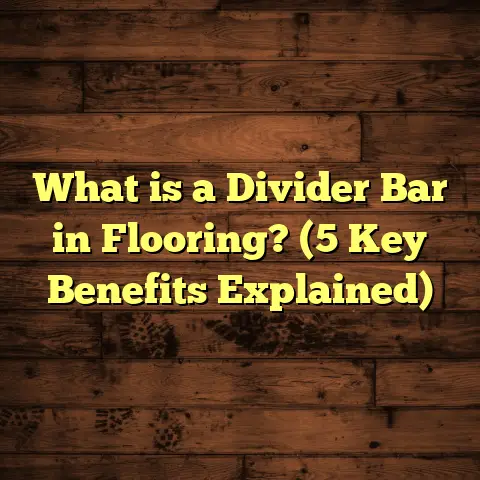What is a Half Floor? (5 Key Benefits in Architecture)
A customer once said to me, “I want my home to feel spacious and open but still cozy and connected. Is there a way to have a floor that’s not quite a full story but adds something special?” That question sparked a lot of thoughts about half floors—an architectural feature I’ve worked with extensively over the years. It’s a fascinating way to add both function and style to a building without the complications of full additional stories.
What Is a Half Floor?
Let me start with the basics: what exactly is a half floor? A half floor is an intermediate level in a building situated between two main floors. Unlike a full story, which covers the entire horizontal area of the building, a half floor only occupies part of that space vertically and horizontally. Think of it as a partial floor that creates an intermediate landing or platform within the vertical progression of a building’s layout.
You often see half floors in split-level homes, loft apartments, or commercial spaces where maximizing vertical space efficiently is important. The half floor can serve many purposes — from extra living areas, offices, or storage to creating architectural interest.
How Does a Half Floor Work?
Picture a staircase that doesn’t simply go straight up but pauses at a landing halfway between two floors. That landing might be built out as usable space—a mini room or seating area that overlooks the space below or adjacent rooms. This creates a half floor.
The height of these intermediate floors usually ranges from 3 to 5 feet. They cover roughly 30% to 70% of the footprint of the floors above or below. This partial coverage helps maintain open sightlines, allowing natural light and air to flow easily through the building.
From my experience, getting the dimensions right is key. If the half floor is too low or cramped, it feels uncomfortable. But with good planning, these spaces feel cozy and intimate while still connected to the rest of the home.
Origins and Evolution of Half Floors
Half floors aren’t a new invention. Historically, split-level homes and mezzanines have existed for centuries in various forms. But modern architecture has embraced them more actively as homeowners seek flexible living environments.
In urban areas where space is limited, half floors allow buildings to pack more usable square footage without increasing height or footprint excessively. They’re also popular in contemporary design for breaking up boxy interiors with dynamic, staggered volumes.
In my own work, I’ve seen half floors evolve from niche architectural curiosities into practical solutions for numerous housing and commercial projects.
Five Key Benefits of Half Floors in Architecture
Now that you understand what half floors are, let’s explore why they’re so valuable. I’ll share real examples, data-backed insights, and some personal stories to highlight their advantages.
1. Efficient Use of Vertical Space
One of the biggest benefits I’ve noticed is how half floors use vertical space efficiently. Instead of adding a full extra story—which can be expensive and bulky—you get more usable area by inserting an intermediate level.
For example, in a renovation project I led for a growing family, we added a half floor between the living room and bedrooms. This became a comfortable reading nook with built-in shelves and seating. The family gained useful space without expanding the building footprint or major structural changes.
Why does this matter? Construction costs increase significantly with full stories because you need more materials (walls, ceilings, staircases), higher structural support, insulation, HVAC extensions, and often more complex permits.
According to data from the National Association of Home Builders (NAHB), adding a full story can raise construction costs by 40–60% per square foot compared to intermediate half floors which typically add only 15–25%. In dollar terms, this can mean saving tens of thousands on projects depending on size and location.
Half floors also help keep property taxes lower since many jurisdictions tax based on total square footage or building height. By adding space in increments rather than full floors, homeowners sidestep hefty increases.
My Personal Experience
When I built my own home years ago, I wanted extra space but was wary of ballooning costs and permits. Adding a half floor library nook was the perfect solution—more room for books and quiet time without breaking the bank. It also made my home feel layered and interesting rather than boxy.
2. Enhanced Natural Light and Airflow
Have you ever been in a house where sunlight barely touches the lower floors? Half floors can change that.
Because they cover only part of the horizontal space, half floors leave room for sunlight to flow vertically through stairwells or double-height ceilings. Skylights or clerestory windows become more effective when there isn’t a full floor blocking light.
In one loft apartment I worked on, we created a half floor overlooking the living area below. The result was stunning: sunlight poured in from large windows above and flowed freely through multiple levels, brightening every corner.
Better airflow is another benefit. Since half floors don’t completely close off spaces vertically, air moves more naturally through rooms. This improves ventilation and can reduce reliance on mechanical cooling or heating.
Studies back this up: Research published by Building Science Corporation showed that multi-level spaces with partial floors improve daylight penetration by 30–40% compared to traditional stacked floors. Likewise, natural ventilation rates increased by about 25%, enhancing indoor air quality.
These benefits aren’t just about aesthetics—they impact health and energy bills.
3. Visual Interest and Unique Interior Design
Half floors bring character that few other design elements can match. They break up monotonous floor plans into smaller volumes that feel dynamic and inviting.
A client once told me she wanted her home to “feel alive.” Adding glass railings and staggered half floors achieved just that—each level offers new sightlines and surprises while maintaining openness.
Architectural magazines often highlight split-level designs because they create layered views—where you might see parts of rooms above or below from different vantage points. This adds depth to interiors that boxy layouts lack.
In my projects, creative use of half floors lets me play with materials like wood beams, exposed brick walls, or metal railings that become focal points. These elements create homes that feel personal and memorable.
4. Privacy Without Isolation
This benefit surprises many people when I explain it. Half floors strike a balance between openness and privacy.
Say you want your teenager to have their own study area near family spaces but not completely isolated down a hallway or behind walls. Half floors provide semi-private zones where people feel separate but not cut off.
I remember working with a family who wanted quiet homework spots for their kids but still wanted supervision from common areas. We designed half floor nooks next to living rooms with partial walls and open railings. The kids had their space but parents could keep an eye from just a few steps away.
Similarly, home offices benefit by being quiet yet visually connected spaces when placed on half floors near main rooms instead of separate closed offices.
5. Cost-Effective Remodeling Option
If expanding your home feels overwhelming due to cost or permits, half floors offer an affordable alternative.
When remodeling older houses or apartments with tall ceilings or underutilized attics/basements, converting part of these spaces into half floors can add function without major structural overhaul.
From my experience, retrofitting attics into half floors gained clients extra bedrooms or offices at roughly 25–35% less per square foot than full-floor additions. This works especially well when ceiling heights are already generous.
Building codes sometimes treat mezzanines or half floors differently from full stories regarding fire safety regulations or permit requirements. This can speed up approvals and reduce fees—a big relief for homeowners eager to avoid months-long waits.
Diving Deeper: Technical Details Behind Half Floors
Having talked about benefits, let’s get into some technical details that often come up when designing or installing half floors.
Structural Considerations
Half floors must be supported structurally without compromising existing foundations or frameworks. Common approaches include:
- Using steel beams or reinforced wood joists to span open areas
- Attaching new framing securely to load-bearing walls
- Ensuring stair landings can hold expected loads safely
- Accounting for lateral forces if walls are removed or openings created
In one commercial project I consulted on, engineers designed steel frames for mezzanine half floors with load capacities exceeding 50 pounds per square foot—enough for office furniture and foot traffic with margin.
Ceiling Heights and Building Codes
Building codes generally require minimum ceiling heights for habitable spaces—often around 7 feet (84 inches). Half floors must meet these minimums where people stand or move around regularly.
Sometimes designers leave lower headroom near stairs or storage areas but keep main walking zones compliant. This balance keeps costs down without sacrificing comfort.
Local codes also regulate fire exits and smoke ventilation in split-level designs involving half floors. Checking these early avoids costly redesigns later.
Staircase Design
Short flights connecting half floors need careful design for safety and comfort:
- Tread depth should be at least 10 inches for secure footing
- Risers generally range from 7 to 8 inches high
- Handrails must follow code height requirements (usually 34–38 inches)
- Open risers may be allowed but need child safety features
I’ve installed staircases in multiple homes where compact half floor stairs fit snugly into corners without wasting space yet felt sturdy and easy to climb daily.
Materials Choice
Half floors often use lighter materials when possible to reduce load:
- Engineered wood flooring instead of heavy stone
- Lightweight steel framing rather than concrete slabs
- Glass railings paired with wood posts to keep visual openness
Choosing materials also impacts acoustics—half floors with hard surfaces may carry sound more readily between levels. Adding rugs or acoustic panels helps dampen noise.
More Stories From My Projects
Here are some additional anecdotes that illustrate the versatility of half floors:
- A young couple wanted an art studio close to living spaces but separate enough for focus. We designed a half floor studio overlooking their main room so they could work while chatting with guests below.
- A homeowner converted part of their garage ceiling into a mezzanine half floor for storage plus an occasional guest bed—saving money on buying larger homes.
- In an office renovation, adding half-floor meeting pods improved employee collaboration without sacrificing open-plan energy.
- A restaurant I consulted for created raised dining platforms (half floors) offering intimate seating inside an otherwise large industrial space—boosting customer satisfaction.
Each





